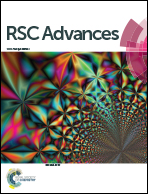Universal model for defect-related visible luminescence in ZnO nanorods†
Abstract
We study the optical properties of ZnO nanorods (NRs) fabricated by chemical bath deposition, hydrothermal, and the vapour–liquid–solid method (VLS). Scanning electron microscopy demonstrates differences in the structural properties for the various samples. The optical emission properties are studied by photoluminescence (PL) spectroscopy where all samples are characterized by a UV and visible emission band. The visible emission band is due to defects in the nanorods. VLS samples show a blue shift in the visible region of the PL spectra with respect to the other samples, however, all three samples are fitted with the same three visible Gaussian components under varying percent contributions due to the structural differences. The visible defect components are characterized by blue (B), green (G), and orange (O) states with energies at 2.52 eV, 2.23 eV, and 2.03 eV, respectively. The applicability of this universal model for visible B–G–O defects is tested against the literature and successfully fitted regardless of the fabrication method. Differences in the percentage contribution for the visible B–G–O defects is explained by variations in the fabrication method. This model indicates how defects can be controlled based on the fabrication method. Furthermore, the B state, which is associated with the ‘green luminescence band’, results from a transition from the defect level to the valence band, or possibly a shallow-acceptor, according to photoluminescence excitation measurements. The role of the B state in sensing applications is discussed.


 Please wait while we load your content...
Please wait while we load your content...